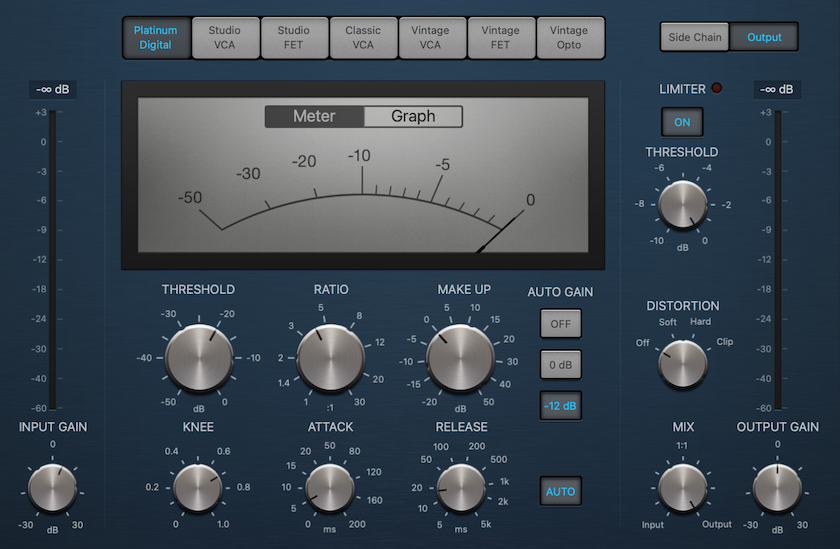Audio compression helps smooth out your recordings. Here’s how it works and when you should use it.
Audio Compression: arguably one of the more complex-yet-useful audio effects out there. Seeing countless forums of aspiring audio engineers asking whether compression is even necessary demonstrates the subtlety of this effect. To an untrained ear, it’s difficult to distinguish; however, once understood, compression can be a powerful effect. In this article, we will break down the primary functions and parameters of compression and when to use it.
What Is Compression?
Audio compression is an audio effect tool that balances out the dynamic range between the loudest and quietest parts of a sound. This is a go-to tool to help tame those prominent peaks that stick out too much, but it can also tighten up transient sounds for some punch.

Compression is most commonly used in drums, which is a great example of how a compressor works. The initial strike of a snare drum is what is called a transient, the loudest part of the signal. Adding compression here will allow the listener to hear that snare transient equally in context. It’s able to keep the tightness of the hit, while evening out the overall dynamic range.
Parameters of a Compressor
Using a compressor requires using a few parameters. Since compression is a process of reducing dynamic range, sometimes we need to compensate for reduced volume. Furthermore, compression can further shape your sound for a polished performance. So, what are the controls we need for compression?
Threshold — This indicates the level (in decibels) at which the compressor will work. When an audio signal goes beyond the given threshold, it will be compressed. Setting the threshold is signal-dependent, meaning that there is no set rule of where the threshold should be set. To tame high peaks, whatever the level meter is showing, set the threshold a few decibels below. Furthermore, the amount of gain reduction is dictated by the Ratio.
Ratio — The compressor needs to know how much to compress the audio signal. This is determined by the ratio. For example: if we have a ratio of 2:1, and part of the audio signal goes over the threshold by 2dB, it will be attenuated to 1dB above the threshold. So, for every 2dB that exceeds the threshold will be reduced to 1dB. The same applies to a ratio of 4:1 – for every 4dB that exceeds the threshold, the signal will be reduced to 1dB. The higher the ratio (e.g. 20:1) the more extreme the compression will be. When the compression is within the extreme realms, this is known as Limiting, a brick wall compression where no signal passes the threshold.
Attack and Release — Both of these parameters (measured in seconds) further shape the compression effect with how fast the compressor works as well as how fast the signal returns to its original volume.
Attack is how long it takes for the signal to be compressed after going over the threshold. Quicker attack times are great for more aggressive sounds, and are also great for controlling the dynamics for a more polished performance. Slower attack times work better on smoother sounds, resulting in a more gentle compression.
Release is how long it takes for the compressed signal to return to its original level. A fast release can help with taming aggressive transients for a bolder sound. A slower release time can help smooth the dynamics and is great for sounds that have more of a sustain.
Makeup Gain — Using a compressor does tend to reduce the overall volume depending on how much you are compressing. To make up for this, we have a makeup gain. Like it says on the tin: it makes up for what is lost in the overall volume. If you have a signal that has been reduced by 5dB after being compressed, you can add 5dB of makeup gain. Since the compressor is only reducing the peaks, we can still increase the overall volume, while keeping those peaks at bay.
Knee — A parameter that isn’t so crucial unlike the threshold and ratio — the knee controls the response of the compressor to the audio signal. Having a hard knee has a more distinct trigger, meaning that no compression will happen until the threshold has been crossed. Conversely, a soft knee is a much more gradual process, where compression is gradually added when approaching and passing the threshold.
Compression in Context
Compression is mainly used on sounds that have prominent transients, such as percussive impacts, drums or dialogue. However, compression can be used on any type of sound.
When designing sound effects, applying a compressor can help control and shape transients. This is particularly useful for heavy sounds like gunshots or impacts. Playing around with the attack and release time can influence the way the transients behave.
Compressors can also be used to help balance frequencies in a sound. Using a tool like a multiband compressor allows us to have more control over the frequency bands (low, mids and highs) with each having its individual compressors.
Below is an insightful video from David Dumais Audio that demonstrates the use of compression on sound effects. Be sure to listen with headphones to hear the differences between the dry and the wet signal.
When working with dialogue, applying a compressor will help control the dynamics, as well as make it sound much more present and polished. The attack and release times here are very important. Fast attack (around 1ms) times are perfect for tightening the dynamic range, but be wary and don’t get too ambitious as a super fast attack time will give the effect of the dialogue sounding further away.
Using a slow attack time (around 20 ms) will result in a bigger sound due to some of the original signal coming through before the compression is applied. However, this isn’t so advisable for dynamic control. The same goes with a fast release (between 50-100 ms) — use this for more dynamic control. A slow release (between 500 ms to 1 second) is suitable for smoothness in dynamics.
Audio engineers will also use a de-esser, which is a type of compression plug-in that aims to tackle the “s” sounds in dialogue. This type of compressor can isolate those harsh frequencies that carry those specific sounds and apply a compressor to reduce the harshness.
This is a rundown video from Aftertouch Audio of a signal chain for dialogue in which they explain the uses and benefits of compression on dialogue!
So, how do we know when to use it?
This question leaves many aspiring audio fanatics scratching their heads. Whenever I do sound design or sound editing, I question whether I even need compression!
Ask yourself whether you want the dynamic range of your sound to be even. This is usually an indicator of whether you will need a compressor. Suppose you are working with dialogue or singing vocals. In that case, you are more than likely going to need some form of compression, whether it’s a de-esser, multiband or a generic compression to clean up those peaks and keep the volume consistent.
Does your sound need more punch? Particularly for transient sounds, like impact sound effects, using a compressor can add some more power to your sound, in conjunction with ensuring those peaks aren’t too invasive in the overall mix. Often, using a compressor is just a matter of adjusting parameters until you feel that it’s at the level you are happy with. Bypassing the compressor can give you a good indication of whether the compressor is making a real difference.
This is one of the more complex elements in audio production and can take some time to fully understand, as well as being a super subtle effect that you mostly only actively hear when you’re actively listening. The best way to understand is to try it out yourself if you have a DAW, and listen to the differences. From here, you can gauge whether you would benefit from using a compressor. But don’t tear your hair out if you have trouble understanding as you may not need it at all!
Cover image via Freepik.
Looking for filmmaking tips and tricks? Check out our YouTube channel for tutorials like this . . .



